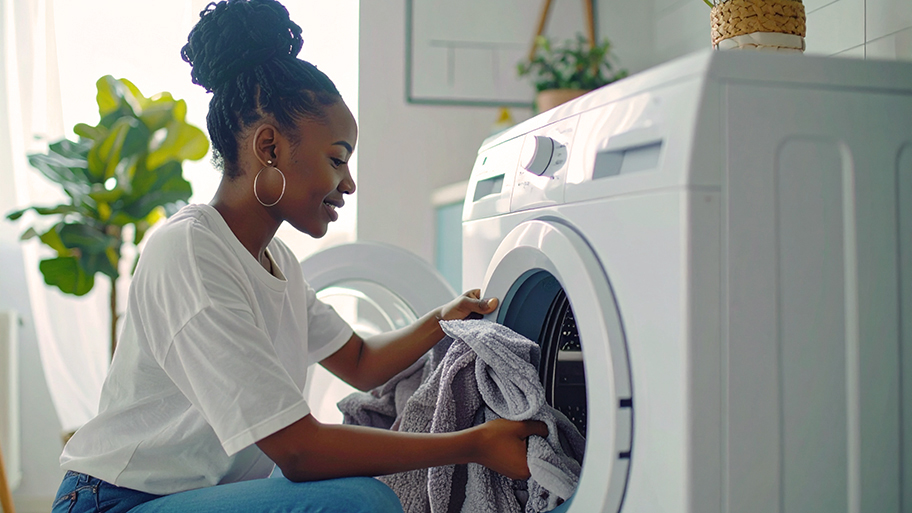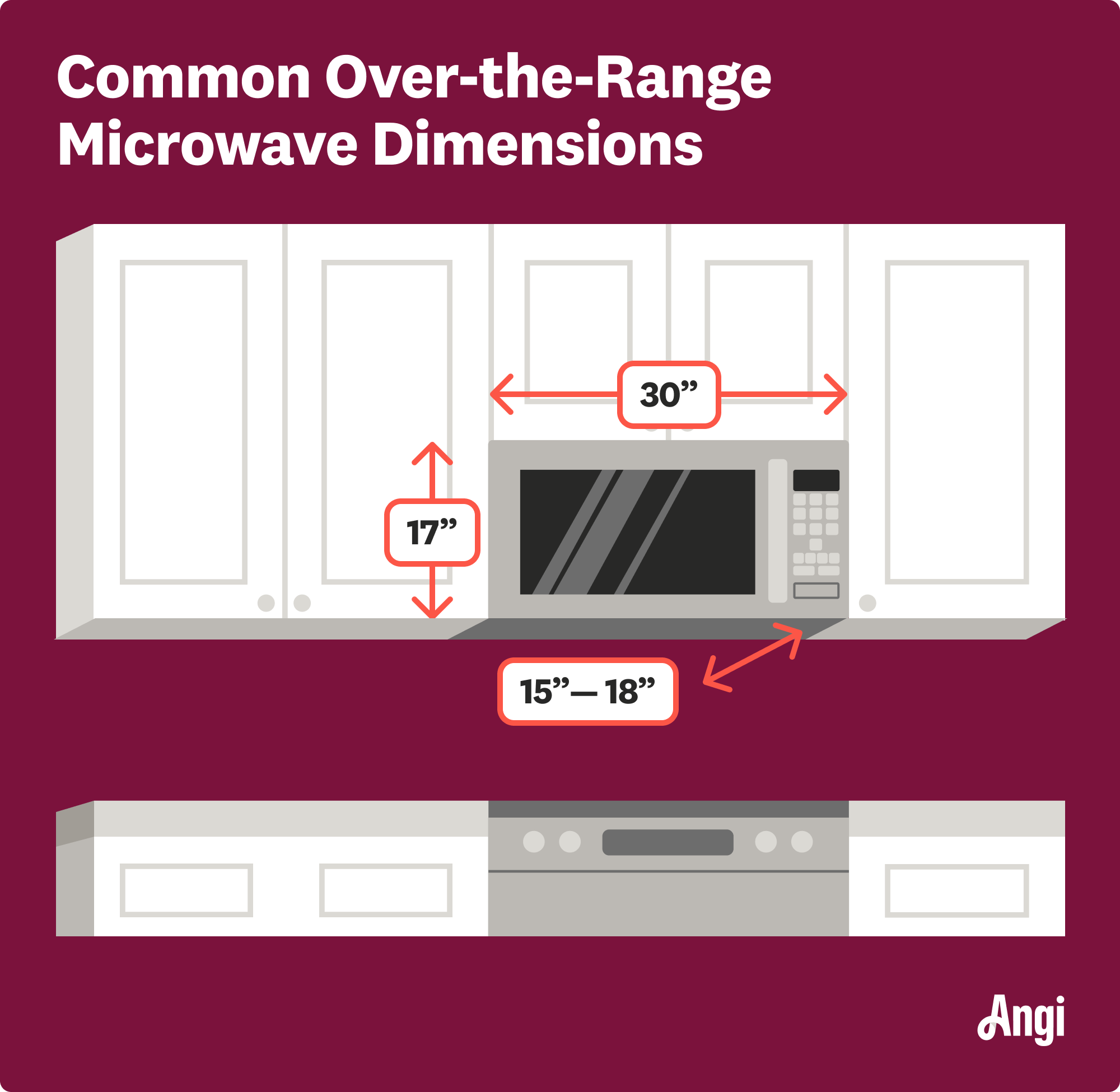
Discover the average washing machine repair cost, key price factors, and expert tips to help you budget and save on repairs for your home.
Time to pull out your trusty tape measure


Over-the-range microwaves are usually around 17 inches in height.
You can hold a tape measure against the side of your microwave to determine its height.
There should be at least 30 inches of clearance between the range and the cabinet above the microwave.
You should have at least 13 inches of space between the cooktop and the bottom of the microwave.
Over-the-range (OTR) microwaves may be a sleeker alternative to traditional countertop models, but they’re also much harder to install. Even if you’re replacing an existing OTR microwave, you’ll need to take a few different measurements to make sure your new unit will fit in your kitchen. So, how do you measure the height of an over-the-range microwave, exactly? Let’s walk through it.

As its name suggests, an over-the-range microwave is mounted above your stove or range. Many people install this type of microwave to save counter space, but it offers other benefits, too. Specifically, OTR microwaves have vents to capture smoke and odors from your cooktop. They have built-in lights as well, which is particularly useful in kitchens with limited natural lighting.
When it comes to OTR microwaves, there are two kinds of height measurements to keep in mind: the height of the microwave itself and the clearance space between the microwave and your cooktop.
Over-the-range microwaves are typically around 17 inches in height, but there are also low-profile models that are about 10 inches tall. To measure yours, hold a tape measure against one of the microwave’s vertical sides.
When installing an OTR microwave, you should maintain at least 30 inches of clearance between the top of the cooking surface and the bottom of the cabinet above the microwave. You can measure this distance by running a tape measure from the tallest point of the cooktop to the underside of the upper cabinet. Be sure to do this before you buy a new microwave so you understand the maximum microwave height for your space.
Once the microwave is in place, there should be at least 13 inches between the cooking surface and the underside of the microwave. This will give you enough room to use your stove comfortably and safely. To determine the height of this area, subtract the height of your new microwave from the total clearance space that you measured previously. If you’re left with 13 inches or more, there’s enough room for the microwave.
Again, make sure to run these calculations before you purchase a microwave; otherwise, you could get stuck with an appliance that’s too tall for your space. If you aren’t confident in your measuring skills, it might be better to call a professional microwave installer near you.

In addition to height, there are a few other size factors to consider when shopping for a new over-the-range microwave.
For starters, you’ll need to know the width of the cutout—which is the area where the microwave will go—in order to buy the right size microwave. To do this, hold a tape measure across the open space of the cutout, stretching it from the vertical edge of one cabinet to the edge of the opposite cabinet.
Fortunately, cutout widths typically align with standard microwave sizes. For reference, OTR microwaves are typically around 30 inches in width, but some models may be bigger or smaller.
It’s also important to measure the depth of the cutout. You can do this by measuring from the wall to the outer edge of the cabinet that will sit above the microwave.
If you want your microwave to fit that space snugly, choose a model with the same depth as the cutout. You can also pick a unit that’s deeper than the cutout, but just be aware that it will jut out from your cabinets. When the microwave door is closed, most over-the-range microwaves are 15 to 18 inches deep.
I had a fantastic experience with them . My refrigerator stopped cooling, and they responded quickly, scheduling me for the very next day. The technician was professional, explained everything clearly, and had my fridge up and running in no time. The price was fair ( made a research) and I...
Perfect. Bertie arrived at the time he said he would arrive and he did a great job hauling the appliances through some very tight spots. Work was clean and professional. I'm so happy to have found them. Thank you!
Professional and efficient AC repair AC repair from Green City Pros! Jimmy was courteous and had our AC running smoothly in no time. Thumbs up for the excellent service, guys !
They repaired a leak in my roof. I found them to be very friendly and knowledgeable. They arrived when they said they would and didn't keep me waiting. They made the repair and then inspected the rest of the roof and sealed all of the other flashings. Great job!
Francis was awesome! Extremely professional and willing to resolve issues. I truly appreciated his hard work and will definitely use his company for my future projects.
quick and expert diagnosis and repair. fair price. great service and no headaches
Professional, courteous and great quality. Would hire the team again.
Doug did an outstanding job. We contacted him back in July (based on his reviews on Angie's List)-- because we needed some carpentry work done at our home in Westhampton Beach. He was on time (actually arrived early for our first meeting), reliable, a pleasure to deal with and most of all his...
It was mainly because of the people who were renting the house. The inside was trash. The toilet was dirty, carpet was gone, and appliances were gone. Everything was a total disaster. Clearly they lacked care. It looked like worse of the worst rental homes. It was a mess from the outside and...
From average costs to expert advice, get all the answers you need to get your job done.

Discover the average washing machine repair cost, key price factors, and expert tips to help you budget and save on repairs for your home.

Discover the average ice maker repair cost, key price factors, and tips to save. Learn how to budget for your ice maker repair and when to repair or replace.

Looking to keep warm this winter without the high utility bills? Use this pellet stove installation cost guide to see what a natural heating solution will cost.

If you’re interested in alternative heating options, you need to see our pellet stove pros and cons. Get the right heater for your home.

Working over an open flame gives you better control over your cooking. Learn more about the benefits of converting an electric stove to gas.

Whether a small or deep scratch, follow these simple steps to remove scratches from stainless steel to keep your appliances shining.